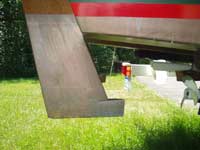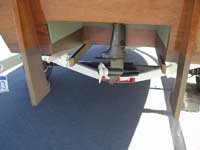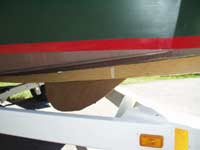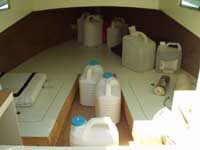| by Bob Chamberland - Suttons
Bay, Michigan - USA |
I think it has been almost a year since you’ve
heard the latest on my Campskiff project. Right after
the last correspondence I launched Campskiff. The
launch was not a spectacular success. To the amusement
of the assembled throng “Campskiff” would
not agree to be steered. There was absolutely no steering
control. Fortunately I was able to get back to the
launch ramp without messing up any of the fine boats
that were nearby.
I spent a week or so consulting with local “experts”,
others on the internet sites and in general just working
over the situation in my mind. The consensus of opinion
boiled down to the following possibilities:
1. The twin skegs were interfering. The solutions
proposed were: use a long shaft engine; cut off
the skegs.
2. Because of the light construction the boat
did not float to its lines and thus had no “bite”
in the water so the front just slewed around. The
solution: ballast. The boat weighed in dry at 890#.
I had calculated a weight of 1800# from the drawings.
“Redwing”, I believe, weighs in at around
900# dry. It was suggested that a shallow keel might
help.
3. I needed more power.
I tried simple solutions first. I installed an 8'
long by 2" deep keel from the stem back. I launched
at the marina and was managing to get out of the harbor
but when I got out in the breeze I could not steer.
I was ignominiously towed back in by a friend.
I had written
Robb White over the winter and his conclusion
was that it HAD to be the twin keels.
(click images to enlarge) |

|
|
The next few trials were with varying amounts of
ballast to bring the boat to its lines. This time
I went to a remote fisherman’s ramp where I
would have no audience and where I could take the
time I needed. This time, with 300# or so of bricks
and sandbags I did have some steering control forward
but reverse was dicey. I motored out into the bay
and tried out various maneuvers. The upshot was that
the boat would steer but a full circle turn required
a turning diameter of 100 feet (30m) or so. With that
I decided to finish some other projects and park “Campskiff”
until 2006.
Over the winter I corresponded with builders and
owners of “Redwing 18s" and “Campskiffs”.
No one identified with my problem however I was told
in a couple of instances that turning “required
a bit of room”. I think most of those I reached
were using the hi-thrust 9.9 engines.
Early this spring we had a tolerably warm day so
I loaded ballast and tried again. Same bad results.
So I went home to brood. I had written Robb White
over the winter and his conclusion was that it HAD
to be the twin keels. Well I decided to bite the bullet
and start cutting. I cut out the horizontal portions
of the twin keels aft of the transom, loaded the ballast
and went to my fisherman’s ramp. Results were
better but not much.
| The skegs
lopped off |

|
|
My conclusion was that the twin keels are interfering
and also that the front of the boat just slides where
it wants. I noticed on Mr Bolger’s proa, published
in “Messing About in Boats”, that he had
a small skeg or keel like structure fore and aft.
I’m not sure if it’s a skeg or keel or
perhaps both since there is one fore and one aft.
They are both keel and skeg depending on which way
the boat is sailing. Any way I decided to add a small
“keel” forward. So the next trial was
with the horizontal members of the twin skegs cut
out, the ballast redistributed and the small keel
forward. Reverse was still not too good but when I
got out into the bay to try out my mods I was amazed.
To port, the boat turned on a dime. Starboard turns
were more limited because the tiller arm was stopped
by the side of the engine well.
 |
I decided
to add a small “keel” forward. |
|
So the boat can turn.
Today I decided on another trial. A process of elimination
was necessary to determine just what was required
of all these various modifications. Earlier on I had
added temporary sections of plywood back in where
I had removed the horizontal bits of the twin skegs.
The ballast from the last trial was left in place
and I launched. There was a bit of breeze but I had
no trouble backing and hawing to head out the channel
and continue out into deep water.
In deep water I tried out the combination. Turning
to port was OK but not as impressive as when the horizontal
bits of the twin skegs had been removed. Turning to
starboard was even less impressive and I also had
problems with cavitation. I returned to the ramp to
remove the plywood from the skegs and try again. I
could not get the port piece unscrewed but I did remove
the insert on the starboard skeg. It was almost amazing
the difference in performance. Port turns on a dime.
Of course no change in starboard turns since there
was no change in the configuration. For the next trial
I took the boat out of the water and removed the insert
on the port side skeg, removed some of the ballast
forward and adjusted the remaining ballast farther
aft but still forward of the CG. Slow speed turns
were impressive. In reverse turning was best at idle
speeds, goosing it just sloshed water over the transom.
Turns at higher speeds were not as good as at slow
speed but very good, probably should be considered
normal. With the change in the ballast there was some
squatting at full speed. There was no cavitation.
 |
For the
next trial I removed some of the ballast
forward and adjusted the remaining ballast
farther aft but still forward of the CG. |
|
So what’s the conclusion. Cut off the twin
skegs but first try out a long shaft engine. The cavitation,
I believe, was caused by the unbalanced ballast. The
stern was high since there was an untoward amount
of weight forward. An extra passenger in the cockpit
would probably remedy that but the permanent solution
is to balance out the ballast. The real key is that
little “keel” forward. I believe the remnants
of the twin skegs hanging off the transom are still
interfering but mostly with the higher speed turns.
The boat could use more power but mostly to get a
little more speed at less than wide open throttle.
I think the prevailing use of the 9.9 hi thrust engines
in other “Campskiffs” and “Redwing
18s” is the way to go.
Ultimately I think there are a couple of combinations
that will work. First, a long shaft engine, restored
skegs, balanced ballast and retained forward “keel”.
The “keel” should be trimmed progressively
until it doesn’t work anymore then install the
previous version. Alternatively, remove the twin skegs
completely aft of the forward edge of the engine,
balance the ballast, and trim the forward “keel”
as detailed above. Several years ago “Duckworks”
ran an article
about an Australian “Redwing” which had
the motor well eliminated and the engine hanging off
the “true” transom. I noticed in the photos
that this boat did not float on her lines either except
with passengers and crew. I’m sure this engine
arrangement works better than the well.
Any adjustments are for someone else. “Campskiff”
is for sale (without engine). Now I know that the
boat will work properly I’ll let someone else
do the final modifications with a good conscience..

More about Bob's Campskiff:
|